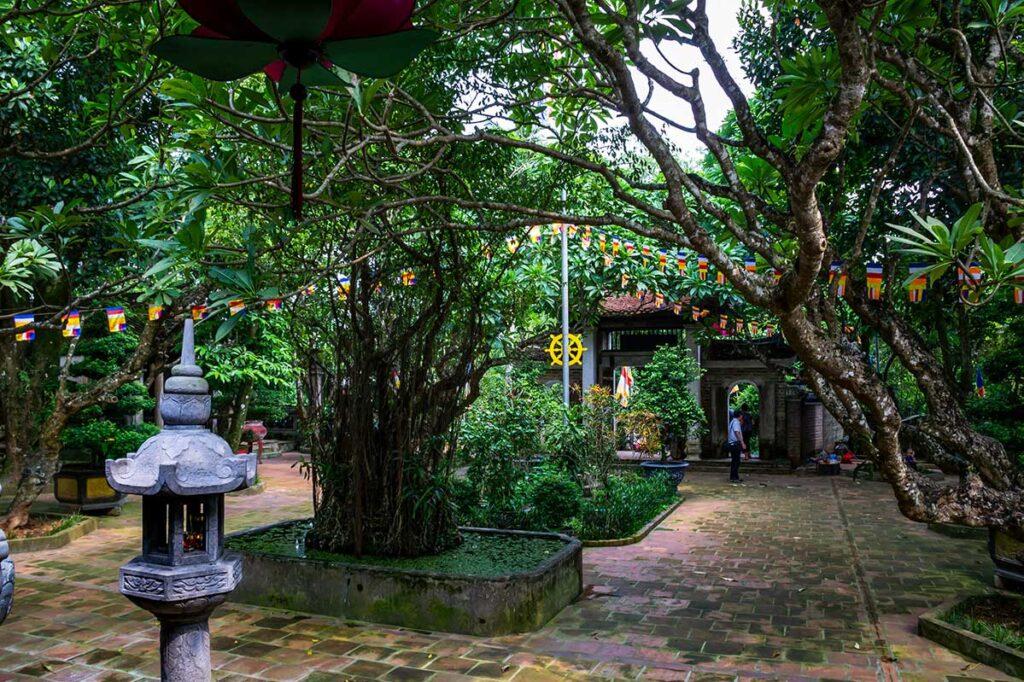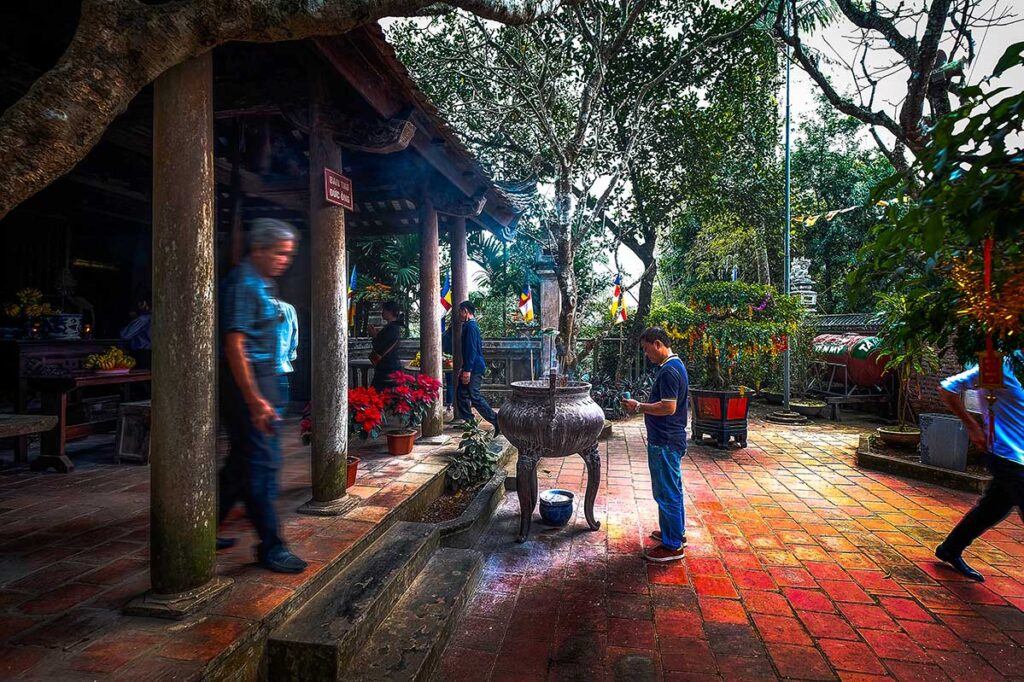About 30km west of Hanoi, nestled on a picturesque hillock said to resemble a buffalo, stands Tay Phuong Pagoda (also known as Sung Phuc Pagoda). This centuries-old Buddhist temple, a testament to Vietnam’s rich spiritual heritage, offers you a captivating glimpse into the country’s artistic and religious traditions.
What is Tay Phuong Pagoda?
Tay Phuong Pagoda isn’t just a single structure; it’s a complex of three single-level buildings arranged in descending order on the hill. Its most celebrated feature is the collection of 62 meticulously carved wooden statues, many dating back to the 18th century. These figures, representing “the conditions of man,” showcase the exquisite craftsmanship and spiritual depth of Vietnamese artistry.

The pagoda’s history dates back to the 8th century, making it one of the oldest pagodas in Vietnam. Its unique architecture, serene atmosphere, and cultural significance make it a must-visit destination for those seeking to explore the spiritual heart of Vietnam.
History of Tay Phuong Pagoda
Tay Phuong Pagoda has a long and storied history, with its origins dating back to the 8th century, making it the second oldest pagoda in Vietnam after the Dau Pagoda in Bac Ninh. The pagoda was rebuilt in 1636 under the reign of King Le Than Tong and underwent a complete renovation in 1794 during the Tay Son dynasty, when it was renamed Tay Phuong Ancient Pagoda.
Legend has it that the pagoda’s birth is linked to the spread of Buddhism in Vietnam. Cao Bien, a ruler under the Tang Dynasty, is said to have built religious structures at the site to block important spiritual positions. However, the legend remains a mystery. Historically, the pagoda was constructed in the 8th century and has since been an important center for Buddhist worship and culture.
Throughout its history, Tay Phuong Pagoda has undergone several reconstructions, with significant renovations in 1632, 1657-1682, and the major overhaul in 1794. The pagoda’s architecture, featuring double-tiered roofs and elaborate carvings, reflects the sophisticated craftsmanship and religious significance of the site.
Highlights of visiting Tay Phuong Pagoda
The Three Pagodas
Tay Phuong Pagoda comprises three buildings: Chua Ha (Lower Pagoda), Chua Trung (Middle Pagoda), and Chua Thuong (Upper Pagoda). These structures are built on the mountainside, creating an iconic architectural masterpiece. Each building features wooden frames, terracotta roofs, and intricately carved decorations.
The Statues

One of the main attractions of Tay Phuong Pagoda is its collection of 72 wooden statues, considered rare masterpieces of religious sculpture. These statues, including 18 Arhat statues, are carved from jackfruit wood and date back to the 18th century. They depict various Buddhist deities and historical figures with exquisite detail and craftsmanship.
The Steps and Gates
To reach the pagoda, visitors must climb 238 moss-covered laterite steps. The journey to the pagoda is as captivating as the destination itself, with the steps leading through lush greenery to the gates of the pagoda. The site features two main gates: the Outer (Lower) Three-Door Gate and the Inner (Upper) Three-Door Gate, both showcasing traditional Vietnamese architectural elements.

The Main Pagoda
The main pagoda consists of three parallel buildings: Tien Duong (Front Hall), Trung Duong (Middle Hall), and Thuong Dien (Upper Hall). These buildings are connected by wooden beams and decorated with intricate carvings of dragons, phoenixes, and floral patterns. The pagoda’s architecture symbolizes the Buddhist and Confucian philosophy, with each building representing different aspects of the universe.

Tay Phuong Pagoda Festival
The Tay Phuong Pagoda Festival is held annually on the 6th day of the third lunar month and lasts until the 10th day. This vibrant festival attracts numerous visitors who come to participate in various cultural and religious activities. The main day of the festival includes the Moc Duc ritual, where sacred water is collected to bathe the statues. Visitors can also enjoy traditional games such as tug-of-war, wrestling, and human chess, making it a lively and engaging event that showcases the rich cultural heritage of the region.
Visiting information
Address: Tay Phuong Pagoda, Thach Xa Commune, Thach That District, Hanoi, Vietnam
Opening Times: Open daily from 8:00 AM to 5:00 PM
Entrance Fee: Free for all visitors
Dress Code: Visitors are advised to dress modestly and respectfully, covering shoulders and knees. Do not touch or take any objects in the pagoda without permission, and ask for permission if you want to film or take photos.
How to get there?
Tay Phuong Pagoda is approximately 30 kilometers west of Hanoi Old Quarter. While public transportation options are limited, the most convenient way to reach Tay Phuong Pagoda is by private transportation.
Private car with driver: You can hire a private car with a driver in Hanoi for a comfortable and hassle-free journey. This option allows you to set your own itinerary and combine your visit with other attractions in the area.
Motorbike: If you’re an experienced motorbike rider with a valid license, renting a motorbike in Hanoi can be an adventurous way to reach the pagoda. The scenic route winds through villages and countryside, offering a glimpse into rural life.
Other sights nearby Tay Phuong Pagoda
Thay Pagoda
Located approximately 15 kilometers from Tay Phuong Pagoda, Thay Pagoda is another ancient Buddhist temple complex with stunning architecture and a serene ambiance. It’s famous for its annual water puppet festival held in the spring.
Phu Vinh Bamboo and Rattan Village
Phu Vinh Village is famous for its traditional bamboo and rattan crafts. You can see artisans at work and purchase unique handmade souvenirs, providing a cultural experience and supporting local craftsmanship.
Chang Son Hand Fan Village
Chàng Sơn Hand Fan Village is renowned for its traditional hand fans, crafted by skilled artisans. It offers a glimpse into Vietnam’s cultural traditions and an opportunity to purchase beautiful, handcrafted fans.
Is it worth to visit?
Tay Phuong Pagoda is a unique cultural and historical treasure that offers a peaceful respite from the city’s hustle and bustle. While it may be a bit off the beaten path, its exquisite architecture, ancient statues, and serene atmosphere make it a worthwhile addition to any Hanoi itinerary. Consider combining your visit with other nearby attractions for a full day of exploration and discovery.





